Land Use Strategy (LUS) Delivery Evaluation Project - Volume 1: Main Report
This report provides the fundings of the Land Use Strategy Delivery Evaluation Project undertaken in Scotland between 2012 and 2014. It evaluates eleven case study land use delivery mechanisms to ascertain their effectiveness in translating the strategic Principles of the LUS into decision-making on the ground.
2 Methodology
2.1 The LUS Delivery Evaluation Project is intended to provide an independent and informed observation of what has actually happened as a result of implementing the LUS to date. This type of policy evaluation observes what has actually happened or is happening following the implementation of a policy (rather than what was expected or intended) and is a crucial part of the policy cycle.
The overall approach
2.2 The overall approach to the LUS Delivery Evaluation Project is illustrated at Figure 2.1. The evaluation is centred on eleven case study land use delivery mechanisms. These case studies have been engaged throughout the course of the project (April 2012 - April 2014) to develop an understanding of their relationship with the LUS.
2.3 The evaluation framework (depicted on the centre of Figure 2.1) has informed all other aspects of the project including the specific research methods used and the data collection strategy. In particular, the five broad Research Questions set the framework for all subsequent research tasks i.e. all data collection and analysis has been designed to answer these questions. The Research Questions (see Table 2.2) are based on the Scottish Government's objectives for the project which are detailed in Chapter 1 at paragraph 1.2.
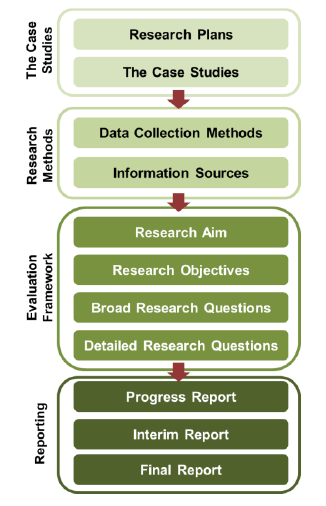
Figure 2.1 LUS Delivery Evaluation Project - overall research approach
Research strategy
2.4 The LUS Delivery Evaluation Project commenced in April 2012 and completed in April 2014. A structured research strategy was put in place early on to ensure that interaction with case studies and data gathering activities could be carried out in a timely manner, providing evidence to inform the Research Questions (see Figure 2.2). This was supported by case study specific research plans which are discussed later on in Chapter 2 at paragraph 2.25.
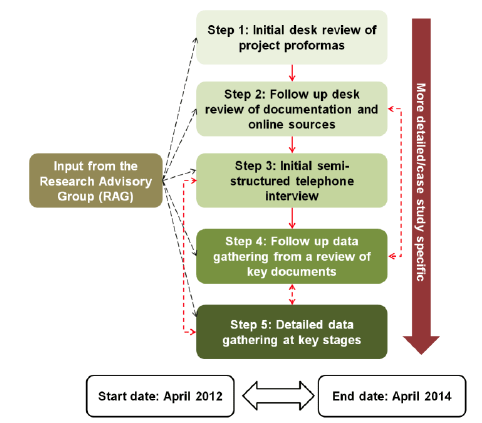
Figure 2.2 LUS Delivery Evaluation Project - research step interactions
- Interaction between research steps is indicated by the red arrows
- Dashed arrows indicate iteration between steps - significant iteration took place between step 4 and 5
- Input from the Research Advisory Group (RAG) was, in effect, provided throughout the project
- As discussed at Table 2.1, the 'key stages' at Step 5 were case study specific
2.5 As shown at Table 2.1, the research was split into five main steps. Early steps were generic and undertaken consecutively whereas later steps were iterative and case study specific. The interaction between the five main steps of the project is depicted on Figure 2.2. In effect, data gathering activities became increasingly refined as the project progressed to the later stages, recognising the diversity of the eleven case studies and the specific focus in each case. The scope and focus of each case study is outlined later on in Chapter 2 at paragraph 2.28 onwards and at Table 2.4.
2.6 The steps and tasks detailed in Table 2.1 clearly show how the research strategy was designed to inform the response to the five broad Research Questions. The approach to steps 4 and 5, for example, was targeted to capture data on relevance and translation of the LUS Principles as well as opportunities/successes and challenges/barriers. As detailed at Table 2.2, this equates to broad Research Questions Nos. 1, 3 and 4.
2.7 The project was coordinated by a Research Advisory Group (RAG) with overall project management provided by the Scottish Government Rural and Environment Science and Analytical Services (RESAS) Division. In addition to Scottish Government RESAS, the RAG comprised representatives from other Scottish Government Divisions (including Land Use and Biodiversity; Natural Assets and Flooding; Planning and Architecture), Forestry Commission Scotland (FCS), Scottish Environment Protection Agency (SEPA), Scottish Natural Heritage (SNH) and Historic Scotland. As illustrated on Figure 2.2 the RAG provided input to the project at all key stages. This included three physical meetings between the RAG and the research team as follows: 1) project inception meeting in April 2012; 2) Interim Report meeting (combined with case study workshop - see paragraph 2.15) in June 2013; and 3) project progress meeting in January 2014.
Table 2.1 Summary of key research and data gathering steps
| Step |
Purpose |
Task/key information to gather |
|---|---|---|
| 1. Initial desk review of the project proformas |
To acquire basic information and understanding about each case study |
Task: Undertake a review of the project proformas supplied to the Scottish Government by each case study to develop an initial understanding of each case study's scope and timeline for key stages. Information being gathered:
|
| 2. Follow up desk review of documentation and online resources |
To supplement the basic information and understanding about each of the case studies in the proformas as necessary |
Task: Undertake follow up desk review of documentation and online resources to supplement information in the proformas as necessary. Information being gathered:
|
| 3. Initial semi-structured telephone interview |
To make direct contact with the case study representatives, address any queries they have, supplement the basic case study information, explore potential scope/focus for the evaluation and gain an initial understanding of the case study's awareness of the LUS and the LUS Principles |
Task: Undertake initial semi-structured telephone interview with case study lead contacts to introduce ourselves, the project, supplement the information on the project from steps 1 - 2 above, discuss the potential scope that the evaluation will focus on and gauge an initial understanding of the awareness of the LUS and the Principles. Information being gathered:
|
| 4. Follow up data gathering from a review of key documents |
To develop a fuller understanding of each project's existing use of/reference to the LUS and its Principles (implicitly or explicitly) and the potential relevance of the LUS and its Principles as demonstrated through key documentation and online material |
Task: Undertake a review of key document(s) and online information about each case study to supplement the information obtained via the initial semi-structured telephone interview. Record any points for clarification or key assumptions made so that these can be explored in more detail during the subsequent data gathering steps (such as additional semi-structured interviews). Information being gathered:
|
| 5. Detailed data gathering at key stages relevant to each case study |
To gather additional information from the case studies as necessary to inform the headline evaluation questions, including the deliverability of each LUS Principle in terms of both process and outcome |
Task: At key stages for each case study during the course of the evaluation, gather data using a variety of methods (e.g. semi-structured telephone and face-to-face interviews, document review etc). This involved a variety of those involved in the case study, e.g. the project lead, members of a steering group/board/partnership, wider stakeholders with an interest in the project. Identify possible examples/illustrations of LUS Principle consideration in practice. Information being gathered:
|
2.8 In following the research strategy outlined at Table 2.1 and depicted on Figure 2.2 the research produced a wealth of qualitative data. Drawing on the evaluation framework, the subsequent analysis of this data informed a reasoned, structured and evidenced response to each of the five broad Research Questions. The approach taken to the analysis is Research Question specific. A short description of the analysis approach is provided in each of the results Chapters (i.e. Chapters 3 - 6).
Research methods
2.9 Table 2.1 outlines the research strategy followed in the LUS Delivery Evaluation Project. Data collection employed two main research methods: 1) document review; and 2) semi-structured interviews. This was supported by a case study workshop, based on the findings of the Interim Report, which was held in June 2013.
2.10 The main objective of the document review was to identify the stated aims, objectives, policies, approach etc of each case study in relation to land use/management. This information directly informed the five broad Research Questions (e.g. how and where are LUS Principles or LUS Principle type issues being considered? Is there evidence of specific methods being used successfully?) as well as highlighting specific issues that were then explored in more detail through the semi-structured interviews.
2.11 The methodological approach adopted was variable depending on the purpose of reviewing a specific document. For example the follow-up desk review of documentation at step 2 (see Table 2.1) used a proforma with standard questions that were imposed on the documents. Questions included:
- Does the source explicitly refer to the LUS?
- Does the source explicitly refer to the Principles included in the LUS?
- From reviewing the source, in summary, which of the LUS Principles are likely to be relevant and not so relevant to the case study and why?
2.12 Conversely, the more detailed review of documentation undertaken at step 4 used a criteria based approach to help identify documented evidence of LUS Principles (either explicitly or implicitly) being considered/translated, in terms of process and outcome issues. This task directly informed Research Question No.1 on translation of the LUS Principles into action 'on the ground' (see Table 2.2) and used bespoke criteria designed to help the research team identify where LUS Principles were being considered/translated (see Appendix 1).
2.13 The main objective of the semi-structured interviews was to capture diverse qualitative data to inform the detailed response to each of the five broad Research Questions. As with the document review, the specific methodological approach adopted in each interview was variable. For example, the initial interviews undertaken at step 3 used a generic interview schedule for each case study. Key points considered included:
- Discussion around the proposed scope/focus for the evaluation of that case study
- Discussion around the relevance of each LUS Principle to the case study and any perceived or actual barriers to its translation and any existing methods or examples of good-practice for translating the Principle into action on the ground
- Case study specific questions based on the initial document review
2.14 Earlier interviews (step 3 on Figure 2.2) were recorded due to their more general/open-ended nature. These interviews produced large amounts of general data which was then utilised at various stages throughout the project (e.g. informing more detailed interviews in step 5). As such, a detailed, comprehensive record of these interviews was required. Later interviews undertaken in step 5 were much more focussed (generally only taking 20-30 minutes) and a written record was sufficient. All interviews were undertaken in confidence and no personal quotation/attribution of interviewee comments has been used in this report[4].
2.15 The case study workshop was held in June 2013. The objectives of the workshop are listed below. Further details of the approach and workshop outputs are provided in the Case Study Workshop Summary Report at Appendix 2. In particular, the outputs of the workshop played a key role informing the second half of the project in terms of scoping the data collation activities and evaluation focus. The case study workshop objectives were as follows:
- To provide an opportunity to share good practice between the case studies
- To ground truth with the case studies the draft findings of the evaluation presented in the Interim Report
- To explore in more depth with the case studies the opportunities and successes and/or barriers and challenges to translating and applying the LUS Principles on the ground
The evaluation framework
2.16 The evaluation framework comprises a suite of headline/sub Research Questions. These questions are based primarily on the research objectives set by the Scottish Government (see Chapter 1 paragraph 1.2) but they have also drawn on generally accepted good-practice in evaluation design such as the UK Treasury's Magenta Book (HM Treasury, 2011) which sets out the steps that should be followed when planning and designing an evaluation.
2.17 The questions have been designed to tease out an understanding of how the eleven case study land use delivery mechanisms are considering and translating the LUS Principles into action 'on the ground' (and therefore how they may be supporting the delivery of the LUS itself). The full suite of Research Questions is shown at Table 2.2.
2.18 The questions have also been designed to address a range of related issues to support a greater understanding of the potential appropriateness of using existing land use delivery mechanisms to deliver the LUS. This includes consideration of issues relating to context, characteristics, methods and approaches and barriers/constraints to applying the LUS Principles.
2.19 Where relevant, the Research Questions have been supported by specific methodological devices and tools. For example, bespoke evaluation criteria were developed to structure the data collection and analysis for Research Question No.1 (see Table 2.2). These criteria were designed to help the research team identify where the LUS Principles are being considered/translated in terms of process and outcome issues - i.e. where the LUS Principles are being translated into decision-making 'on the ground'.
2.20 The wealth of qualitative data produced during the project (see Table 2.1 and Figure 2.2) provides the input to the evaluation framework. In essence, the evaluation framework provides the structure for the analysis of this data, informing the five broad Research Questions and meeting the overall aims and objectives of the project (see Chapter 1).
Table 2.2 LUS delivery evaluation Research Questions
| Headline questions |
Sub-questions |
|---|---|
| 1. Have the high level LUS Principles been (implicitly or explicitly) translated into decision making on the ground? And if they have, how well? |
|
| 2. In what situations and how have the LUS Principles been successfully applied? |
|
| 3. What methods and approaches are working well, and not so well, and why? What successful aspects might be applied more generally across Scotland in a range of different circumstances? |
|
| 4. Are there any key barriers to the application of the LUS Principles? And if there are, what are the likely reasons and what lessons can be learned for more general application across Scotland? |
|
| 5. What are the emerging themes on how best to apply the LUS Principles to different circumstances and processes across Scotland? Are there any particular lessons for specific circumstances and different groups of decision makers and stakeholders? |
|
The case studies
2.21 As mentioned at Chapter 1, the overall approach to the evaluation project is centred on eleven case study land use delivery mechanisms. The Scottish Government anticipate that the range of existing land use delivery mechanisms in Scotland (including the mechanisms illustrated by the eleven case studies considered in this research) will provide the means by which the LUS and the high level LUS Principles will be translated into practical land use/management decision-making on the 'on the ground'.
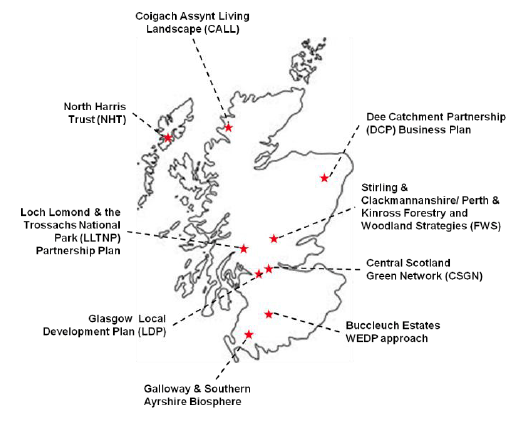
Figure 2.3 Approximate locations of case study land use delivery mechanisms
- The Figure above shows the approximate location of nine of the eleven LUS Delivery Evaluation Project case studies. The Figure depicts approximate centre points of the geographical areas encompassed by case studies. For example, the CSGN case study covers just under 10,000km2 of Central Scotland stretching from Girvan in the southwest to Dunbar on the east[5] (i.e. a significantly larger area than that implied by the point location shown on the Figure)
- The location of the Buccleuch Estates case study indicated on the map above is the approximate location of the Queensberry Estate. The Buccleuch Group own three estates[6] in Scotland though this research has focussed in particular on the Queensberry Estate and the application of the Buccleuch Group's Whole Estate Development Plan (WEDP) approach therein
- The Monitor Farms and Wildlife Estates Scotland (WES) case studies are not indicated on the Figure above as they are national programmes In essence, the geographic location of these case studies (i.e. a farm or estate) could be anywhere in Scotland
- The Forestry and Woodland Strategy (FWS) case study comprises two separate FWS - one for Stirling and Clackmannanshire and one for Perth and Kinross. At this scale and using approximate centre points to highlight case study location, both FWS are in broadly the same location hence why only one point is used
2.22 This process is the Scottish Government's preferred mechanism by which the LUS itself will be delivered. This approach is set out in Section 5.4 of the LUS which describes how the Strategy will not introduce new layers of complexity or bureaucracy.
2.23 In this regard, the eleven case studies are the vehicle for evaluating the implementation of the LUS, with respect to the various Research Questions detailed at Table 2.2. The eleven case study land use delivery mechanisms are introduced in Table 2.3 and a map showing their approximate location is provided at Figure 2.3. Further details of the scope/focus of the evaluation for each case study are provided at the end of this Chapter.
Table 2.3 Details of the LUS Delivery Evaluation Project case studies
| Case study |
Summary details |
|
|---|---|---|
 |
Buccleuch Estates The Whole Estate Development Plan (WEDP) |
The WEDP approach is a Geographic Information System (GIS) led spatial land use/management prioritisation tool that has been developed by Buccleuch Estates |
 |
Central Scotland Green Network (CSGN) |
The CSGN is a regional initiative intended to change the face of Central Scotland by restoring and transforming the landscape. The lead partners[7] - Forestry Commission Scotland (FCS) and Scottish Natural Heritage (SNH) - have been have been able to identify from within their own budgets up to £1M/year to support land use/management projects that will help to deliver the CSGN on the ground. The CSGN is also a national development within the National Planning Framework (NPF) |
 |
Coigach Assynt Living Landscape (CALL) |
The Coigach - Assynt Living Landscape (CALL) is one of the largest landscape restoration projects in Europe, aiming to benefit the land, the people and the local economy in the north west of Scotland. The CALL Partnership have also recently been successful in a Stage 1 bid to the Heritage Lottery Fund (HLF) Landscape Partnership programme |
 |
Dee Catchment Partnership Business Plan |
The Dee Catchment Partnership is an independent association of agencies, organisations and individuals that work together to deliver improved water management in the Dee catchment in Aberdeenshire. The work of the Partnership is coordinated through a Business Plan that sets out priorities for action |
 |
Glasgow City Council Local Development Plan (LDP) |
Glasgow City Council is in the process of developing its statutory Local Development Plan (LDP) as per the requirements of the Planning etc (Scotland) Act (2006). This has involved the undertaking of Strategic Environmental Assessment (SEA) and extensive public and stakeholder consultation |
 |
Forestry and Woodland Strategies (FWS) Perth and Kinross and Stirling and Clackmannanshire |
Perth and Kinross Council and Stirling and Clackmannanshire Councils working in partnership are in the process of developing Forestry and Woodland Strategies (FWS) in line with the Forestry Commission Scotland's (FCS) The Right Tree in the Right Place Guidance. This has involved the undertaking of SEA and Habitat Regulations Assessment (HRA) |
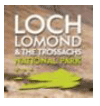 |
Loch Lomond and the Trossachs National Park (LLTNP) National Park Partnership Plan (NPPP) |
The NPPP sets out the overall partnership approach to managing the Loch Lomond and Trossachs National Park based on the park's special qualities, challenges and opportunities. One of the mechanisms being used to deliver the NPPP are Individual Partner Agreements (IAPs) which set out the specific actions key partners will deliver over the next five years |
 |
Monitor Farms Programme |
The Monitor Farms programme is a facilitated forum to share ideas among livestock farmers across Scotland. The programme has a focus on production but can also incorporate wider land use/management issues as appropriate (e.g. agri-environment scheme opportunities etc) |
 |
North Harris Trust (NHT) |
NHT (comprising ten locally elected directors and a representative of the John Muir Trust) manages 25,000ha of North Harris on behalf of the community who purchased the land through a community buyout in 2003. The aims of the Trust are to increase employment opportunities, address local housing needs and protect and enhance North Harris' cultural and natural heritage |
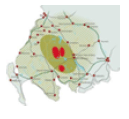 |
Galloway and Southern Ayrshire Biosphere |
The Galloway and Southern Ayrshire Biosphere is a UNESCO Biosphere - places with world-class environments that are designated by the United Nations to enhance the relationship between conservation and development by innovating and demonstrating approaches to sustainable development at a regional or ecosystem scale, so that people and nature are in a better more productive balance |
 |
Wildlife Estates Scotland (WES) Initiative |
The WES Initiative is an accreditation system that seeks to promote best practice in game and wildlife management and to improve the evidence base for species and habitats across Scotland |
2.24 As far as possible, the eleven case studies have been selected to capture a broad cross-section of land use delivery mechanisms from the extant land use delivery 'landscape' in Scotland (see Table 1.2 in Chapter 1). To this end, the Scottish Government and the RAG (see paragraph 2.7) drew up a long list of potential case study land use delivery mechanisms before the project commenced. From the long list, a short list was then identified on the basis of selection criteria. The criteria were:
- Coverage of LUS Principles (both within and across the whole set of case studies)
- Location/geographical spread - recognising the need for the case studies to come from a variety of different land use/management contexts
- Sector - recognising the need for case studies to capture a range of different perspectives and sectors. Some case studies should be quite focussed in this regard while others should cover multiple sectors/interests
- Scale - e.g. from the farm/holding scale up to regional scale initiatives
2.25 The analysis at Chapter 4 (see Table 4.1 in particular) highlights the diversity of the eleven case studies that were eventually taken forward for consideration in the LUS Delivery Evaluation Project. The potential wider relevance of this research (including lessons learnt for more general application across Scotland and the potential limitations of a case study based research approach in this sense) are discussed, in particular, at Chapter 7.
Case study research plans
2.26 Research plans have been developed and refined throughout the project. These were informed by the proposed scope/focus for each case study (see Table 2.4) which developed from the original proformas provided by the case studies, ongoing discussions with the Scottish Government and Research Advisory Group (RAG) and interviews with the case studies.
2.27 The design of the research plans has been undertaken in such a way as to steer data gathering towards specific case study decision-making activities of interest. In effect, these are the specific stages within the case study policy/plan/project development cycle that have been construed as the 'on the ground' decision-making stage for the purposes of this research and the response to Research Question No.1 in particular (see paragraph 2.28 onwards and Table 2.4).
2.28 Accordingly, the scope/focus of the case study research is dictated by the specific decision-making stage of interest. This then informs the research plans - when to collect data - and the specific research methods used - how to collect data. Case study research plans are included at Appendix 3.
Defining what is meant by 'on the ground'
2.29 The overarching aims and objectives of the evaluation project (see Chapter 1) and Research Questions (see Table 2.2) include several references to translating the LUS Principles into decision-making 'on the ground'. This notion of 'on the ground' has been a challenge for the project as it can mean different things to different people or in different contexts. This section describes what the research means by 'on the ground', recognising that this is different for each case study as explained further at Table 2.4 below.
2.30 At first sight, one might infer that the reference to 'on the ground' within the project aim and objectives and Research Question No.1 (see Table 2.2) directly relates to practical action that 'breaks ground' and that has a tangible impact in terms of land use/management activity within the landscape. Examples of these more practical actions could include:
- Forest harvesting and planting operations
- Erection of deer fencing
- Habitat creation
- Habitat management
- Grazing management in upland areas
- Footpath maintenance
- Activities that regenerate vacant and derelict land
- Development of new urban greenspace
- Construction of built development
- Livestock density
- Agro-chemical inputs
2.31 Although a key delivery issue for the LUS undoubtedly relates to these more practical land use/management actions, there are other delivery issues that are more concerned with elements of process, awareness raising and public engagement.
2.32 These issues may not directly result in tangible changes in the landscape but are no less important in terms of the LUS' ability to deliver sustainable land use outcomes in the long term. Key issues here include the need to engage people from all walks of life in land use/management decisions and raising awareness of the inherent link between Scotland's land resource, human wellbeing and sustainable economic growth.
2.33 The consideration of LUS Principles in policy-development is also vital in this regard e.g. in Scotland Rural Development Programme (SRDP) budget allocation and scheme/option design or the design of placemaking policy within Local Development Plans (LDPs). This mechanism provides the link between the national level LUS and practical land use/management action 'on the ground'.
2.34 In addition, what is meant by 'on the ground' in the context of this research project is influenced by the scope of the research and the specifics of the adopted methodology, especially with respect to project timescales (i.e. the scope of the case study decision-making processes covered during the lifetime of the research project). The research is case study based and each of the case studies is involved in the development and delivery of one or more policies/plans/projects, as detailed at Table 2.3, that are being evaluated as part of this research.
2.35 In essence, the research is capturing a 'snap-shot' of the eleven case study policy/plan/project development cycles as dictated by the temporal scope of the research project i.e. April 2012 - April 2014. Within this timeframe, some case studies will go through a full cycle whereas others will only cover certain aspects. This may also be influenced by unexpected factors outside the control of the case studies or the researchers[8].
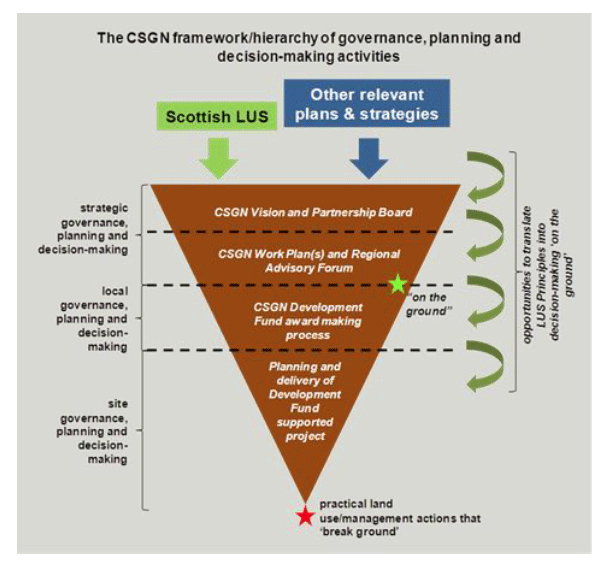
Figure 2.4 CSGN framework/hierarchy of governance/planning/decision-making
- The inverted triangle represents the case study land use delivery mechanism of interest (the CSGN in this instance) and its extant framework/hierarchy of governance, planning and decision-making activities - from strategic to local to site based decisions and ultimately to the delivery of practical land use/management actions that 'break ground' at the point of the triangle
- Within each tier of decision-making however, there is an opportunity for the LUS Principles to be translated into decision-making 'on the ground' where 'on the ground' is construed as the policies, plans, frameworks, actions, key decisions etc within the subsequent lower tier of governance, planning and decision-making
- Within the scope of the LUS Delivery Evaluation Project, it has not been possible, for each case study land use delivery mechanism, to capture information on how the LUS Principles are being considered and translated across the entire framework/hierarchy of governance, planning and decision-making activities. This is due to the timescales of the research relative to the timescales of the case study policy/plan/project development cycles being evaluated
- For each case study, the research team has defined what is meant by 'on the ground' to scope the research activities required to answer Research Question No.1 "have the high level LUS Principles been translated into decision-making on the ground". In the case of the CSGN, 'on the ground' is construed as the process of deciding which applicant projects to award CSGN Development Fund monies to as indicated by the green star on Figure 2.4
2.36 As such, the research team have taken a pragmatic approach to defining what is meant by 'on the ground' for each case study. In most cases, this is likely to be a specific decision-making stage within the case study land use delivery mechanism's wider framework/hierarchy of governance, planning and decision-making activities.
2.37 The premise of this approach however is that these wider frameworks/hierarchies would at some point result in the delivery of practical land use/management activities that 'break ground'. This is illustrated on Figure 2.4 using the CSGN case study as an example.
2.38 In essence, the evaluation of the degree to which the high level LUS Principles have been translated into decision-making on the ground is focussed on process orientated delivery issues (i.e. governance, planning and decision-making) as opposed to practical land use/management activities that directly cause tangible impacts in the landscape.
2.39 To support the evaluation against Research Question No.1 bespoke evaluation criteria were developed to help the research team identify where the LUS Principles are being considered/translated in terms of process and outcome issues - i.e. where the LUS Principles are being translated into decision-making 'on the ground'. The criteria are discussed further in Chapter 3 and are provided in full at Appendix 1.
2.40 Table 2.4 defines what is meant by 'on the ground' for each of the case studies. Using the CSGN case study as an example, Figure 2.3 depicts the framework/hierarchy of governance, planning and decision-making activities and the specific decision-making juncture that the research team are construing as 'on the ground' for the purposes of evaluation against Research Question No.1.
2.41 Chapter 3 includes further details of the 'on the ground' decision-making juncture for each case study in relation to the Research Question No.1 evaluation.
2.42 The scope of the research in terms of what is meant by 'on the ground' has had a direct influence over the case study research plans (see paragraph 2.25, Table 2.4 and Appendix 3) and also the scope of the case study specific findings documented in this Final Report.
Table 2.4 Defining what is meant by 'on the ground' for each case study
| Case study |
'On the ground' means… |
Has the 'on the ground' stage been reached in the course of the project? |
|---|---|---|
| Buccleuch Estates - Whole Estate Development Plan (WEDP) |
The application and interpretation of the WEDP approach to specific estates i.e. the degree to which and how the LUS Principles have been incorporated within the WEDP approach and then translated into decision-making at the estate level |
Yes - the WEDP report outlining the rationale for the approach was published in Autumn 2012. Three WEDP pilots have been developed and have started to inform practical land use/management decision-making at the estate level |
| Central Scotland Green Network (CSGN) |
The process of deciding which applicant projects to award CSGN Development Fund monies to i.e. the degree to which and how the LUS Principles have informed the translation of CSGN strategic policy and vision into Development Fund award decision-making |
Yes - several rounds of Development Fund monies have now been awarded, the most recent being for the 2013/14 financial year. The CSGN have recently published their most up to date Work Plan for the period 2013 - 2016 |
| Coigach Assynt Living Landscape (CALL) |
Steering Group decisions informed by comment from the Review Group i.e. the degree to which and how the LUS Principles have been reflected and translated in the outputs and/or outcomes of Steering Group decisions |
Yes - two Review Group meetings have been held since the CALL Project Manager has been in post (September 2011). Several projects have been initiated as a result of Steering Group decisions |
| Dee Catchment Partnership Business Plan |
The process of identifying priorities and making decisions by the Partnership to inform the development of the Business Plan i.e. the degree to which and how the LUS Principles are translated in the priorities, decisions and provisions within the Business Plan |
Yes - the revised Business Plan was launched in June 2013 |
| Glasgow City Council Local Development Plan (LDP) |
The process of developing and adopting Glasgow LDP Supplementary Guidance i.e. the degree to which and how the LUS Principles are translated into provisions within the Supplementary Guidance. Due to the scope of the LDP, the research has considered a specific policy issue within the LDP (environment) and specific Supplementary Guidance (green network) |
No - the development of the LDP has been delayed and public consultation on the Proposed Plan is not anticipated until May 2014. Additional material has been considered where relevant to ensure the evaluation is as comprehensive as possible |
| Forestry and Woodland Strategies (FWS) Perth and Kinross and Stirling and Clackmannanshire |
The process of reviewing the Forest and Woodland Strategy i.e. the degree to which and how the LUS Principles are translated in the new strategy's provisions |
No - the evaluation was initially considering the Highland FWS though programme and timescale issues meant that this case study had to be replaced in September 2013. The replacement FWS - Perth and Kinross and a joint Stirling and Clackmannanshire FWS - are yet to adopt their finalised strategies. The evaluation considered the process of reviewing FWS up to and including consultation on the draft FWS and SEA Environmental Report |
| Loch Lomond and the Trossachs National Park (LLTNP) National Park Partnership Plan (NPPP) |
The process of developing and agreeing the NPPP Individual Partner Agreements (IPAs) i.e. the degree to which and how the LUS Principles are translated into specific actions and provisions within the IPAs |
Yes - the research team have been privy to several draft IPAs though only one of these was suitable for consideration in the evaluation as the others did not have a tangible impact on land use/management issues |
| Monitor Farms Programme |
The appointment of specific monitor farms i.e. the degree to which and how the LUS Principles are incorporated and translated through the land management actions and approaches being tested and considered on specific monitor farms |
Yes - Monitor Farms operates on a rolling programme and numerous farms have joined the programme since its inception |
| North Harris Trust (NHT) |
The decision-making process adopted by the North Harris Trust i.e. the degree to which and how the LUS Principles are considered when relevant decisions are made and then translated through subsequent action |
Yes - the North Harris Trust was formed in 2003 and has since made numerous decisions which have been translated into action including actions that break ground and effect change in the landscape |
| Galloway and Southern Ayrshire Biosphere |
The scoping, development and subsequent implementation of actions emerging from the Biosphere Theme Groups i.e. the degree to which and how the LUS Principles are considered in Theme Group discussions and then translated through subsequent action |
To a degree - the evaluation has focused on the 'getting the best from the land' thematic group. This group met in February 2012 to test a stakeholder engagement approach to integrated catchment management. Documented outputs are available from this meeting though subsequent action has not yet been agreed or delivered |
| Wildlife Estates Scotland (WES) Initiative |
The application and development of the WES accreditation process i.e. the degree to which and how the LUS Principles have been translated within the WES accreditation criteria/process and in decisions to approve the accreditation of applicant estates |
Yes - the WES accreditation scheme was officially launched in February 2013 and a number of estates have since been successfully accredited |
Contact
Email: Liz Hawkins
There is a problem
Thanks for your feedback